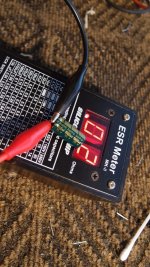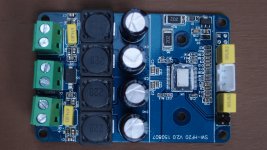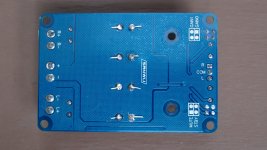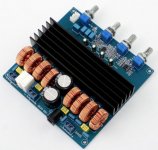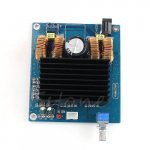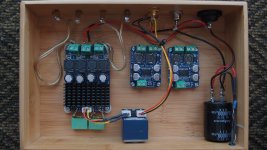I have the same amp. Did u change the caps?, if significantly improved which caps do u recommend?
I have removed and measured these 1000uF/35V Sanyo WG caps and found them all to be .02-.03 mΩ, so they measure okay, but these are known counterfeit capacitors. The "bulging" was probably just a quality control issue on these caps, true bulging caps would reflect a poor ESR measurement and these did not. But I did replace them with ZLH capacitors, 470uF/35V anyway. This is the only mod I have done thus far.
I have tried both 32V and 24V switching power supplies on this unit and, for now, I am believing his board to be just "OK." It is not among the best Class D I have heard, but it does exhibit good detail and plenty of bass. But I find the sound "busy" and "congested" and somehow not satisfying musically.
I plan on changing the input caps to 2.2uF MKT 1822. Also, note the output filter is different than the datasheet. The board has 22uH inductors with 470nF differential caps with 10Ω resistors, other caps value unknown. I may try to modify this to be closer to the datasheet, but working with these SMD devices is not something I'm looking forward to.
The board is generally quiet with no hiss or hum and I believe the gain (which is adjustable via jumpers) is at the default 26.
Attachments
Last edited:
I have removed and measured these 1000uF/35V Sanyo WG caps and found them all to be .02-.03 mΩ, so they measure okay, but these are known counterfeit capacitors. The "bulging" was probably just a quality control issue on these caps, true bulging caps would reflect a poor ESR measurement and these did not. But I did replace them with ZLH capacitors, 470uF/35V anyway. This is the only mod I have done thus far.
I have tried both 32V and 24V switching power supplies on this unit and, for now, I am believing his board to be just "OK." It is not among the best Class D I have heard, but it does exhibit good detail and plenty of bass. But I find the sound "busy" and "congested" and somehow not satisfying musically.
I plan on changing the input caps to 2.2uF MKT 1822. Also, note the output filter is different than the datasheet. The board has 22uH inductors with 470nF differential caps with 10Ω resistors, other caps value unknown. I may try to modify this to be closer to the datasheet, but working with these SMD devices is not something I'm looking forward to.
The board is generally quiet with no hiss or hum and I believe the gain (which is adjustable via jumpers) is at the default 26.
thanks for the detailed information. I ran mine stock with linear 20DCV Astron power supply and after 10 min of moderate loud levels in garage, the heat sink got pretty hot, so now running at 18.5DCV laptop PS. I find sound is pretty good with adequate bass and detail with a simple vocals.
Hi
I have one of these boards.
It stopped working after a few hours
First one channel then ....completly dead,not even a hiss.its a good thing they are cheap.
I cant say much about the sound with only 3-4 hours listening.
I ordered some different boards.
Now for waiting.
Jan
I have one of these boards.
It stopped working after a few hours
First one channel then ....completly dead,not even a hiss.its a good thing they are cheap.
I cant say much about the sound with only 3-4 hours listening.
I ordered some different boards.
Now for waiting.
Jan
The number of cheap class d amps has become uncountable.
I wonder if there really is a market for all that stuff.
One new implementation of the 7498 popped up and caught my attention.
I'm not sure if it is worth the effort, because its blue sanwu-equivalent sounds great in stock form.
I just listened to sanwu amp in stock, except with a on-off volume control, with 12DCV wallwart, it sounds very good playing classical CD, Rite of Spring, Telarc sounds excellent. I have several class d amps, all around $10 chinese knockoffs, and this one sounds the best...
The number of cheap class d amps has become uncountable.
I wonder if there really is a market for all that stuff.
One new implementation of the 7498 popped up and caught my attention.
I'm not sure if it is worth the effort, because its blue sanwu-equivalent sounds great in stock form.
I just listened for about 2hours to sanwu amp in stock, installed a on-off volume control, with 12DCV wallwart, it sounds very good playing classical CD, Rite of Spring, Telarc sounds excellent. I have several class d amps, all around $10 chinese knockoffs, and this one sounds the best... I don't notice much difference with linear vs switch mode PS... Impressive for the cost.
2.1 board
Anyone tried this board?
Input says max 32V and it seems to have those output resistors
New TDA7498 + TL072 Class D 2.1 Amplifier Board 200W+2X100W | eBay
Anyone tried this board?
Input says max 32V and it seems to have those output resistors
New TDA7498 + TL072 Class D 2.1 Amplifier Board 200W+2X100W | eBay
Attachments
Last edited:
It shows alot of similarities to this Yuanjing mono board
New 150W Assembled Class D Amp Board TDA7498 Subwoofer Board Amplifier Module | eBay
New 150W Assembled Class D Amp Board TDA7498 Subwoofer Board Amplifier Module | eBay
Attachments
It shows alot of similarities to this Yuanjing mono board
New 150W Assembled Class D Amp Board TDA7498 Subwoofer Board Amplifier Module | eBay
The layout of the Yuanjing board (and clones) looks very similar to the TDA7498 datasheet, but the values of the differential capacitor (hard to see, looks like 330nF maybe?) don't match datasheet and the inductor values cannot be determined by inspection due to being toroid. Possibly the 22 ohm resistors are under the heat sink? Too many questions. The Sanwu blue board (SW-HF20) is actually quite good and can be obtained from sanwulasers.org, I am liking this board more and more. Output filter is very close to the datasheet and sounding very good with MKT1822 input caps and ZLH electrolytics. A good package for < $20 including mods.
Has anyone tried switching these boards on and off using the "standby" pins as opposed to switching the actual DC input? The standby power consumption of the 7498 is pretty low, and the only thing I'm worried about is whether the speakers will pop if I don't utilize the "mute" pin as well. I plan to simply place a small switch across the standby pins, and keep the original DC barrel jack to connect to a laptop power supply.
The datasheet reports that one should pull up the standby pin and then pull up the mute pin to minimize popping on startup, then do the opposite on shutdown.
(BTW my board hasn't arrived yet, and probably won't be for quite a while)
The datasheet reports that one should pull up the standby pin and then pull up the mute pin to minimize popping on startup, then do the opposite on shutdown.
(BTW my board hasn't arrived yet, and probably won't be for quite a while)
Last edited:
So my Sanwu board (deluxe version with the rca jacks) arrived today. Turns out they actually forgot to solder one of the capacitor legs onto the pcb; I had to do that myself. I'm running this on a 24V 3A supply.
Simply switching the standby pin (as I asked about in my previous post) to turn the amp on and off does work without popping.
Simply switching the standby pin (as I asked about in my previous post) to turn the amp on and off does work without popping.
I'm waiting for that 2.1 YJ board to arrive. Meanwhile I'm toying with the blue heatsink veraion and I love it. No on/off pop and it's performing very well with my 8ohm apeakers. I haven't tried the praised Sanwu board but the blue heatsink one I do recommend. Well worth the 12-13 dollars
I just perused all pages. What is the best sounding board and is there an on/off pop? I'm not sure if I should build a tda or another tpa.
I have 3 7498/7498E boards, this is my favourite (driven by RPi running PcP, Allo Piano DAC, into Q Acoustics 2050i speakers). Adjustable gain, can be switched into mute/standby modes, low current 12v out for LED, smooth volume pot, no pops - a very quiet amp.
TDA7498E 160WX2 digital stereo amplifier board PBTL 220W mono channel 24v-36v | eBay
I have 3 7498/7498E boards, this is my favourite (driven by RPi running PcP, Allo Piano DAC, into Q Acoustics 2050i speakers). Adjustable gain, can be switched into mute/standby modes, low current 12v out for LED, smooth volume pot, no pops - a very quiet amp.
TDA7498E 160WX2 digital stereo amplifier board PBTL 220W mono channel 24v-36v | eBay
Have you compared it with the Sanwu boards?
Having read the whole thread most of the pictures do not work. Is this the best Sanwu board everyone refers to:
Sanwu Amplifier TDA7498
Have you compared it with the Sanwu boards?
Having read the whole thread most of the pictures do not work. Is this the best Sanwu board everyone refers to:
Sanwu Amplifier TDA7498
These are the other 7498 boards I have (I actually run a 4th, a mono driving a sub):
TDA7498 100W + High-power Digital Amplifier Board AMP Board with Radiator 100W | eBay
TDA7498 dual-channel digital Audio Stereo amplifier board 100W+100W 12V 24V car | eBay
I have removed and measured these 1000uF/35V Sanyo WG caps and found them all to be .02-.03 mΩ, so they measure okay, but these are known counterfeit capacitors. The "bulging" was probably just a quality control issue on these caps, true bulging caps would reflect a poor ESR measurement and these did not. But I did replace them with ZLH capacitors, 470uF/35V anyway. This is the only mod I have done thus far.
I have tried both 32V and 24V switching power supplies on this unit and, for now, I am believing his board to be just "OK." It is not among the best Class D I have heard, but it does exhibit good detail and plenty of bass. But I find the sound "busy" and "congested" and somehow not satisfying musically.
I plan on changing the input caps to 2.2uF MKT 1822. Also, note the output filter is different than the datasheet. The board has 22uH inductors with 470nF differential caps with 10Ω resistors, other caps value unknown. I may try to modify this to be closer to the datasheet, but working with these SMD devices is not something I'm looking forward to.
The board is generally quiet with no hiss or hum and I believe the gain (which is adjustable via jumpers) is at the default 26.
Hi DreadPirate,
Can I ask why you would replace the 35V/1000uF capacitors with a smaller value of 35V/470uF? Generally i thought an upgrade entailed increasing the capacitance and not to decrease?
Cheers,
Malato
Hi DreadPirate,
Can I ask why you would replace the 35V/1000uF capacitors with a smaller value of 35V/470uF? Generally i thought an upgrade entailed increasing the capacitance and not to decrease?
Cheers,
Malato
The TDA7498 datasheet has a single 2200uF on the power rail, so 4x470uF (1880uF) for both channels is actually pretty close to the datasheet.
For reference, see that Class D amp datasheets rarely have a great deal of capacitance at this location, here is a list of several amps I have and their datasheet capacitance per channel on the power rail:
TA2020: 180uF
TA2024: 180uF
YDA138: 1uF
TDA7297: 470uF
TPA3110: 100uF
TPA3116: 220uF
And in almost all cases, these are bypassed by one or more smaller capacitors:
TDA7498: .1uF and 1uF
TA2020: .1uF
TA2024: .1uF
YDA138: --
TDA7297: .1uF
TPA3110: .1uF and 1nF
TPA3116: .1uF and 1nF
I also put a large capacitor, 10000uF or so (whatever I have on hand) at the incoming power jack. Why? Because I have a bunch of capacitors that need a home
Typically, the Chinese boards put a lot more capacitance on the board at this location than is called for by the datasheet. I figure the chip manufacturer is in a better position to determine what is best for the chip.
I cannot say one way or another whether the caps I replaced are responsible for this board sounding so good now (I changed them right off the bat when I got the amp and also put MKT1822 2.2uF on the inputs), but on a YDA138, they made a drastic difference in sound quality, I would not underestimate the importance of having a good quality capacitor here, it can make a large improvement in sound.
I have been using this board (SW-HF20) now for a couple of months and am very pleased with the results. Detail and clarity are there, instruments and voices realistic. Good power to drive most small/medium sized moderate efficiency speakers at 24V supply at the default gain. I am running primarily on a set of Pioneer SP-BS22 with the Dennis Murphy mods (new Vifa tweeter and crossover). Mods to the board have been replacing the inputs caps to MKT 1822 2.2uF/63V (NOS from eBay vendor electronics-plus), the rail caps to Rubycon ZLH 470uF/35V (Digikey), and replacing the output caps with a 680nF value (mounted under board in pic) to better match the speaker impedance. The stock output filter is pretty much in line with the datasheet. Board was obtained from sanwulasers.org ($11 shipped). Very quiet, no buzz or hum at any volume. A very nice package overall, should make most happy.
Attachments
Last edited:
- Status
- Not open for further replies.
- Home
- Amplifiers
- Class D
- Ebay cheap TDA7498 boards
